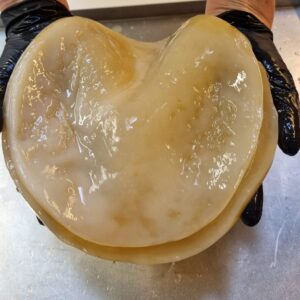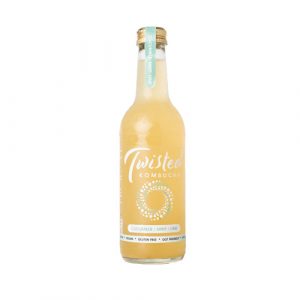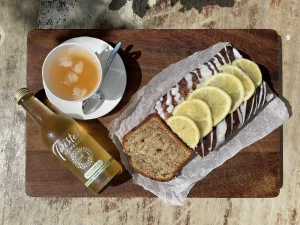
Ah, kombucha – the effervescent, tangy, and slightly mysterious drink that’s been tickling our taste buds and tantalizing our tummies. You’ve probably sipped it in hipster cafes or seen it lining the shelves of health food stores. But what makes this fermented tea truly unique? Well, it’s the SCOBY, the unsung hero behind the scenes, responsible for that magical transformation.
In this blog, we’ll delve into the intriguing world of kombucha SCOBYs – what they are, what they do, and why they’re so essential for your gut health. So, let’s peel back the curtain and explore the marvelous realm of SCOBYs.
What Is A Kombucha SCOBY?
To the uninitiated, “SCOBY” might sound like an obscure acronym or a secret code. In reality, it stands for “Symbiotic Culture Of Bacteria and Yeast.” It’s a remarkable living organism that takes ordinary sweet tea and orchestrates a fermentation symphony. Imagine it as the conductor of a microcosmic orchestra, where various bacteria and yeast strains harmoniously work together to turn sweet tea into the tangy, effervescent goodness we know as kombucha.
Breaking Down Its Components
Let’s unravel the complex world of kombucha SCOBY by taking a closer look at its components. This symbiotic culture of bacteria and yeast is like a bustling city, with various microorganisms each playing a distinct role in the fermentation process:
- Lactic Acid Bacteria (LAB): These friendly bacteria include strains like Lactobacillus, which are widely recognized for their role in fermenting food and creating that signature tang in kombucha. They play a vital part in breaking down sugars into lactic acid, which not only gives kombucha its sour taste but also acts as a preservative.
- Acetic Acid Bacteria: Led by Acetobacter, these bacteria are essential for the transformation of alcohol into acetic acid. This process contributes to the tartness and slight vinegar-like flavor of kombucha, making it unique among fermented beverages.
- Saccharomyces Yeast: The star yeasts, like Saccharomyces cerevisiae, bring the fizz to kombucha. They consume the sugars from the sweet tea and convert them into alcohol and carbon dioxide. It’s this gas that carbonates the brew, resulting in those delightful bubbles.
- Gluconacetobacter Xylinus: This bacterium specializes in producing cellulose during fermentation. This cellulose forms the jelly-like pellicle, also known as the SCOBY itself. It’s the physical structure of the SCOBY, serving as a protective barrier, that allows the microbial community to flourish.
- Additional Yeast Strains: Besides Saccharomyces, other yeast strains like Zygosaccharomyces kombuchaensis are also present, aiding in alcohol fermentation and contributing to the formation of the SCOBY.
- Acids and Organic Compounds: These include acetic acid, lactic acid, and gluconic acid, which are byproducts of the metabolic processes of these microorganisms. These acids not only flavor the kombucha but also act as natural preservatives, extending its shelf life.
Together, these bacteria and yeast form a dynamic community where each organism plays its part in the complex biochemical dance of fermentation. The SCOBY acts as the orchestrator, making sure everything runs smoothly and transforming plain sweet tea into the healthful and flavorful kombucha we know and love.
Why Is The SCOBY So Important?
Now, let’s get to the juicy part – why is the SCOBY such a big deal in the kombucha world? It’s the secret sauce behind the fermentation process.
- Fermentation Wizardry: The SCOBY is the living heart of the kombucha-making process. It acts as a hub for the myriad microorganisms within it, directing the fermentation. As it feeds on the sugars in the sweet tea, the SCOBY guides the conversion of these sugars into various organic acids, including acetic acid, lactic acid, and gluconic acid. This intricate process is the essence of kombucha brewing, giving the drink its distinctive flavors and fizzy nature.
- Flavors and Acids: These organic acids are responsible for the unique tartness of kombucha. Acetic acid lends a vinegar-like tang, lactic acid contributes a mild sourness, and gluconic acid adds a subtle sweetness. These combined flavors create a harmonious taste that’s both refreshing and slightly pungent.
- Preserving the Brew: These organic acids also serve as natural preservatives, extending the shelf life of kombucha without the need for chemical additives. The SCOBY’s work in producing these acids helps protect the brew from spoilage, ensuring that the beverage remains wholesome for consumption.
- Probiotic Powerhouse: As the SCOBY generates organic acids and fosters the fermentation process, it simultaneously nurtures the growth of beneficial bacteria and yeast. This, in turn, makes kombucha a rich source of probiotics, live microorganisms that are good for your gut health. Consuming kombucha with a healthy SCOBY introduces these probiotics into your digestive system, aiding in the balance of gut flora and potentially offering various health benefits.
In essence, the SCOBY is not just a collection of living microorganisms; it’s a remarkable alchemist that transforms a simple mixture of tea and sugar into a complex and healthful elixir. It is the guardian of the brew, ensuring that each sip of kombucha is teeming with flavors, beneficial acids, and gut-friendly probiotics.
SCOBY & Gut Health
Our gut, often called the “second brain,” plays a vital role in our overall health and well-being. It’s not just about digesting food; it houses a complex ecosystem of bacteria – the gut microbiome – which influences everything from digestion to our immune system and even our mood. A healthy gut microbiome is all about balance, and that’s where kombucha’s SCOBY comes into play.
When you indulge in a glass of this fermented elixir, you’re effectively introducing a vibrant community of live bacteria and yeast into your gut. It’s like welcoming a small army of wellness warriors to help maintain that delicate balance within your gut microbiome. The partnership between your gut and the SCOBY, loaded with probiotics, opens up a world of potential health benefits:
- Gut Harmony: The probiotics found in kombucha work in harmony with your existing gut bacteria. They aid in preserving the balance of this internal ecosystem, which is crucial for optimal digestive function. By supporting the equilibrium among these microbial residents, kombucha helps ensure that your gut can efficiently process and extract nutrients from the food you consume.
- Immune Support: A substantial part of your immune system resides in your gut. An equilibrium of gut bacteria is essential for a robust immune response. By introducing beneficial probiotics through kombucha, you’re fortifying your gut’s defense mechanisms, potentially leading to a stronger immune system.
- Mood and Mind: Recent research has unveiled the intriguing “gut-brain axis,” demonstrating that our gut health can have a direct impact on our mood and mental well-being. An imbalanced gut microbiome has been associated with mood disorders and even cognitive function. By fostering a harmonious gut environment, kombucha’s SCOBY may contribute to maintaining a brighter and more stable mood.
What Is A SCOBY Hotel?
Now that you’ve gotten to know your SCOBY, you might be wondering how to take care of it. A SCOBY Hotel is like a kombucha daycare, where you store extra SCOBYs and keep them healthy between brews. This way, you always have a vibrant culture ready for your next batch. Just like we need a good night’s sleep, SCOBYs need a place to rest and thrive when they’re not hard at work fermenting your tea.
What Is A SCOBY Mother?
In kombucha lingo, the “mother” is the original SCOBY that you started with. Over time, as you brew batch after batch, your SCOBY can grow, forming layers. The original, or mother, SCOBY is the one you initially introduced to your sweet tea. As your mother SCOBY continues to produce kombucha, it will give birth to baby SCOBYs, which form new layers on top. Think of the mother SCOBY as the experienced elder guiding the younger generations.
Some Other Fun Ways To Use Your Kombucha SCOBY in the UK
Besides brewing kombucha, your SCOBY can be versatile in the kitchen. From creating SCOBY jerky to experimenting with SCOBY candy or even crafting your SCOBY face masks, there are numerous fun and unconventional ways to utilize these microbial marvels.
- SCOBY Jerky: Yes, you read that right! You can transform your SCOBY into a delectable, tangy jerky. First, thoroughly clean your SCOBY and marinate it in your preferred flavors. Then, dehydrate it until you achieve the desired chewy texture. The result? A unique, probiotic-rich snack.
- SCOBY Candy: Create SCOBY candy by slicing your SCOBY into small, bite-sized pieces and marinating them in a mixture of honey, sugar, or your favorite sweetener. Once they’ve absorbed the sweetness, dehydrate these little treats for a chewy, sweet, and tangy candy that’s both fun and good for your gut.
- SCOBY Face Masks: Don’t be surprised if your SCOBY becomes your new beauty secret. When applied as a face mask, SCOBY can revitalize your skin. It’s packed with beneficial acids and probiotics, offering a refreshing and revitalizing experience for your skin.
- SCOBY Smoothies: For a nutritional boost, consider adding small pieces of SCOBY to your morning smoothies. Blended with your favorite fruits and vegetables, SCOBY introduces a unique tang and probiotic richness to your daily smoothie.
Conclusion
There you have it – a glimpse into the world of kombucha SCOBYs. These living cultures are at the heart of the kombucha-making process, transforming sweet tea into a tangy, fizzy beverage loaded with probiotics.
Not only does kombucha taste refreshing, but it also provides potential benefits for your gut health, immune system, and overall well-being. So, next time you sip on that glass of kombucha, give a little nod of appreciation to the humble SCOBY that made it all possible.
Cheers to the health-boosting wonders of kombucha!
FAQs
What is a SCOBY in kombucha?
A SCOBY, or Symbiotic Culture of Bacteria and Yeast, is a crucial component in the fermentation of kombucha. It’s a living culture that comprises various bacteria and yeast strains, including acetic acid bacteria, lactic acid bacteria, and Saccharomyces yeast. This microbial community is responsible for fermenting sweet tea, transforming the sugars into organic acids, and producing probiotics. The SCOBY looks like a rubbery disk and floats on the surface of the brewing kombucha, sealing it off from the air.
What do I do with a kombucha SCOBY?
A kombucha SCOBY can be used to brew more kombucha. After a batch of kombucha is complete, you can reuse the SCOBY to start a new batch. If you have multiple SCOBYs, you can maintain a SCOBY hotel to store them for future use. Additionally, SCOBYs can be creatively used for making SCOBY jerky, candy, face masks, and even dog treats, depending on your preferences and culinary interests.
How do you keep SCOBY alive?
To keep your SCOBY alive and active, continue brewing batches of kombucha regularly. If you need to take a break, store the SCOBY in some of the finished kombucha in a clean, airtight container, which is often referred to as a SCOBY hotel. Keep it at room temperature and ensure it’s submerged in the liquid to prevent it from drying out. Remember to refresh the liquid every few weeks to maintain the SCOBY’s health.
How long does a SCOBY live?
A well-cared-for SCOBY can live indefinitely. As long as it’s kept in the appropriate conditions, regularly fed with sweet tea, and maintained properly, there’s no set lifespan for a SCOBY. Some SCOBYs have been known to thrive for years, producing numerous batches of kombucha.
When should I throw away a SCOBY?
You should consider discarding a SCOBY if it starts to show signs of mold or unusual discolorations, as this indicates contamination. In such cases, it’s safer to replace the SCOBY rather than risk brewing with a compromised culture. If your SCOBY is unhealthy and not producing good kombucha, it might be time to start fresh as well.
How many times can you reuse a SCOBY?
A single SCOBY can be reused many times to brew kombucha. It’s a robust culture that can carry out the fermentation process repeatedly. As long as it remains healthy and doesn’t show signs of contamination, you can use it for an extended period. If you have multiple SCOBYs, you can continue to use them as long as they remain in good condition. Regular maintenance and care are key to ensuring your SCOBY remains a dependable part of your kombucha brewing journey.












